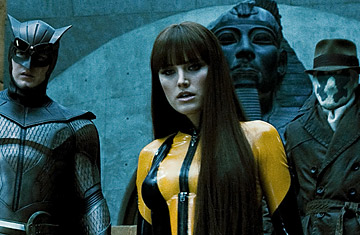
Superheroes Nite Owl (Patrick Wilson), Silk Spectre (Malin Akerman) and Rorschach (Jackie Earle Haley) in Zack Snyder's Watchmen
(3 of 3)
When Snyder showed this four-minute sequence in New York last fall, Gibbons was in the audience and rose to say, cheerfully, "Didn't suck too bad." I'd go further, and say it's among the zippiest, most thrilling assemblages in modern movies, and the film's single great burst of creation and concision. Three times I've seen the credits sequence, and repeated viewings help harvest new goodies — like the few second showing Silhouette in bed, with another woman, murdered, and WHORES scrawled in blood on the walls in her bed (which is different, by the way, from her fate in the novel, where she's killed by a minor adversary). Watching in awe, I'm prodded to wonder why all movies can't be this bold, smart and elliptical. (Watch an interview with Watchmen artist Dave Gibbons.)
Maybe there's no way the rest of the film could match this opening, and for sure it doesn't. Snyder spends much of the movie's 2 hours and 40 minutes on the splatter of crushed limbs, the chatter of Strangelovean science fiction and the nattering of the obligatory romance. He also encourages a little festival of tone-deaf acting. Yet Watchmen has moments of greatness. It proves again that the action movie is where the best young Hollywood brains have gone to bring flesh to their fantasies.
The Passion of the Spliced
As on the other films made from his stuff (From Hell, The League of Extraordinary Gentlemen, Constantine, V for Vendetta), Moore has declined screen credit on the Watchmen movie. But whatever his thoughts on the corruptive properties of cinema, he could have found no more devoted Watch-man than Snyder. The ultimate fetishist-auteur, he takes hallowed pulp artifacts — the '70s horror movie Dawn of the Dead, the Frank Miller graphic novel 300 and now this — and films them with the near-fanatic fidelity of someone constructing an Eiffel Tower replica out of matchsticks.
To Watchmen he brings a reverence for the text that equals Mel Gibson's in The Passion of the Christ and comes close to Gus Van Sant's shot-by-shot remake of the Hitchcock Psycho. He uses Gibbons' panels as virtual storyboards for his scenes, and quotes Moore's ripe dialogue verbatim. (From Rorschach's journal: "Beneath me, this awful city. It screams like an abattoir full of retarded children.... The dusk reeks of fornication and bad consciences.")
Yet this is a real movie, vigorously visualized from Gibbons' template, and daring to splice flashbacks within flashbacks, toying with the conventional notion of screen time. The section showing the mutation of mild-mannered scientist Jon Osterman into Dr. Manhattan is a gem of lucid storytelling. Shuffling the sequence of tenses, the film shows Jon as a young man in love, a fellow scarred by a nuclear accident, a boy watching his watchmaker dad, a superhero who can change size and location at will, a middle-aged stud letting his old love slip away as he finds someone younger and finally a sad sack of blue mourning the ordinary life he lost. Again, all is conveyed in a few minutes, a few quick deft strokes.
The movie also has more than its share of long, clumsy scrawls. The budding romance between Dan and Laurie is tepidly drawn and wanly performed; those who've seen 300 know that Snyder is in no way an actor's director. It's not the energizing ineptness of an exchange in an Ed Wood movie, or the carefully detailed high camp of the performances in David Lynch's Dune. It's just, mostly, inert. (The two self-starters are Haley, who does right by his grizzled role, and Morgan, a Robert Downey Jr. knockoff, who chews the scenery and his stogie with equal aplomb.) And while the climax is unusual in a comic-book movie — bad guy does very bad thing, then escapes his comeuppance by persuading folks that what he's done is really kind of a good thing — it lacks the kick of apocalyptic retribution the mass audience expects and deserves.
Maybe Watchmen is one of those cult films that doesn't expand beyond the true believers. It probably won't make even alternative movie history. It certainly contains its share of popcorn breaks: hit the concession stand whenever Dan and Laurie start their mooning. But it bravely pursues its agenda with a monomaniacal grandeur, on the order of Speed Racer and Synecdoche, New York. (Loyal readers will understand that I mean this as a compliment.) Both admirable for and cramped by its fidelity to the Moore vision, this ambitious picture is a thing of bits and pieces. Yes, the bits are glorious, the pieces magnificent. Still, this Watchmen is more like a swatch-man.
